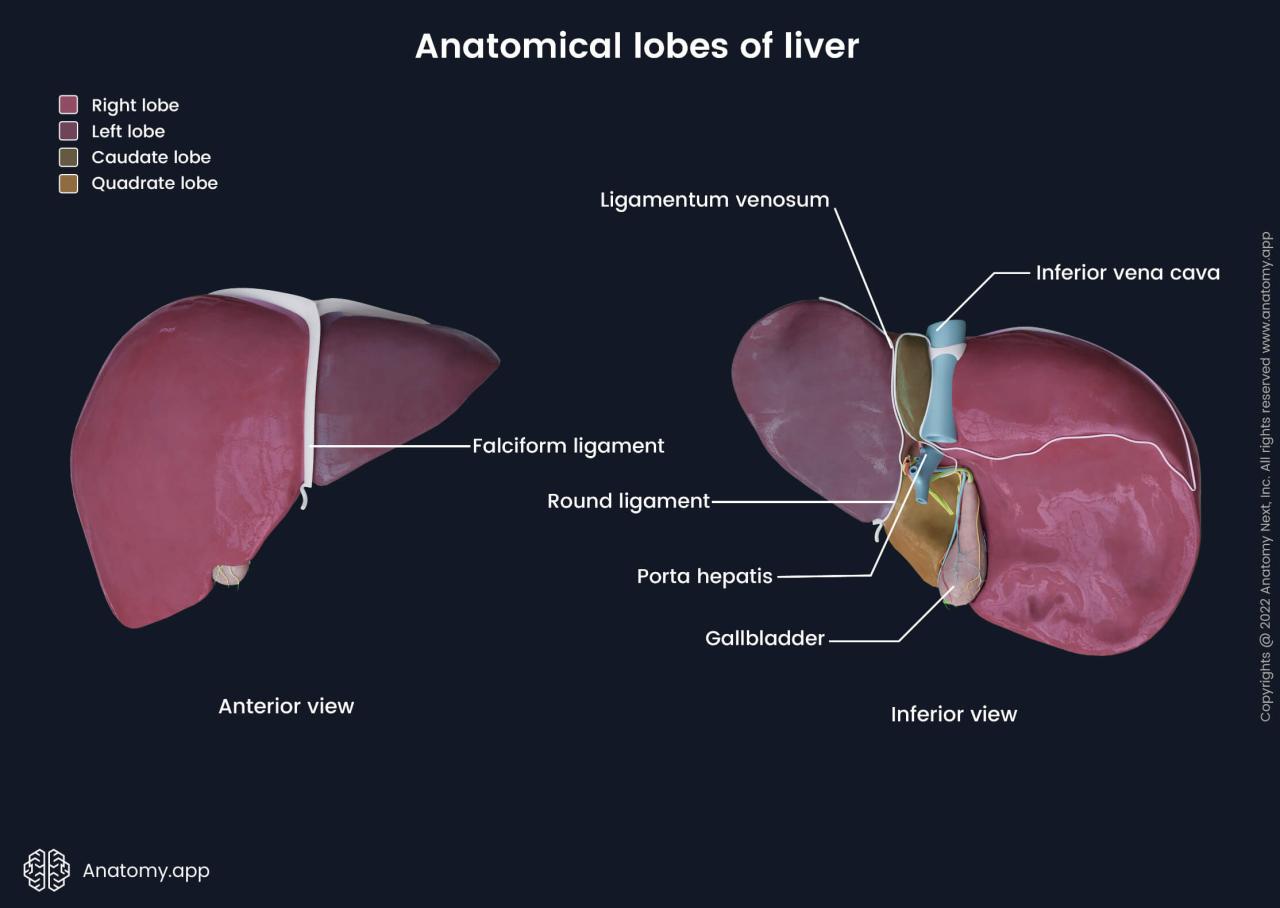Identify the highlighted lobe of the liver – The liver, an organ of paramount importance, takes center stage as we embark on a journey to identify its highlighted lobe. This exploration delves into the realm of anatomy, providing a comprehensive understanding of the liver’s structure and function.
The liver, situated within the abdominal cavity, is a vital organ responsible for a multitude of physiological processes. Its intricate architecture comprises distinct lobes and segments, each with its unique characteristics and functional significance.
1. Anatomic Overview of the Liver: Identify The Highlighted Lobe Of The Liver
The liver, the largest internal organ in the human body, is located in the upper right quadrant of the abdominal cavity, just below the diaphragm. It is divided into two main lobes, the right and left lobes, which are separated by the falciform ligament.
The right lobe is larger and makes up approximately 70% of the liver’s mass, while the left lobe is smaller and comprises the remaining 30%.
Lobes and Segments of the Liver
- Right Lobe:The right lobe is further divided into six segments:
- Segment I (Caudate Lobe)
- Segment II
- Segment III
- Segment IVa
- Segment IVb
- Segment V
- Segment VI
- Left Lobe:The left lobe is divided into two segments:
- Segment II
- Segment III
2. Identification of the Highlighted Lobe

The highlighted lobe in the provided image is the right lobeof the liver.
Visual cues that aid in its identification include:
- Its larger size compared to the left lobe
- Its location on the right side of the body
- The presence of the gallbladder on its inferior surface
3. Structural Characteristics of the Highlighted Lobe
The right lobe of the liver is the larger and more complex of the two lobes. It has a dome-shaped appearance and is characterized by its smooth, convex surface.
Fissures and Grooves, Identify the highlighted lobe of the liver
The right lobe is divided into segments by three fissures and two grooves:
- Right Sagittal Fissure:Separates segments II and III from segments IV, V, and VI.
- Left Sagittal Fissure:Separates segments II and III from the left lobe.
- Transverse Fissure:Separates the right and left lobes.
- Umbilical Groove:Marks the location of the attachment of the umbilical vein to the liver.
- Gallbladder Fossa:A depression on the inferior surface of the right lobe where the gallbladder is located.
4. Functional Significance of the Highlighted Lobe
The right lobe of the liver performs various essential functions, including:
- Metabolism:The right lobe is responsible for the majority of the liver’s metabolic functions, such as glucose regulation, lipid metabolism, and protein synthesis.
- Bile Production:The right lobe produces bile, which aids in the digestion and absorption of fats.
- Detoxification:The right lobe detoxifies harmful substances, such as drugs and toxins, from the blood.
5. Clinical Relevance of the Highlighted Lobe

Identifying the right lobe of the liver is crucial in various clinical settings:
- Diagnostic Imaging:The right lobe can be visualized using imaging techniques such as ultrasound, CT scans, and MRI scans, aiding in the diagnosis of liver diseases and abnormalities.
- Surgical Procedures:Surgeons need to identify the right lobe during liver resections, transplantation, and other surgical interventions.
6. Comparative Anatomy of the Highlighted Lobe

The right lobe of the human liver shares similarities with corresponding lobes in other mammalian species:
- Primates:The right lobe in primates, such as chimpanzees and monkeys, is also larger than the left lobe and occupies the right side of the abdominal cavity.
- Rodents:The right lobe in rodents, such as rats and mice, is relatively smaller and has a more compact shape compared to the human liver.
- Canines:The right lobe in canines, such as dogs and wolves, is typically more elongated and has a more prominent caudate lobe.
Clarifying Questions
What is the largest lobe of the liver?
The right lobe is the largest lobe of the liver.
What is the function of the left lobe of the liver?
The left lobe is responsible for producing bile, which aids in digestion.
What are the clinical implications of identifying the highlighted lobe of the liver?
Identifying the highlighted lobe is essential for accurate diagnosis and surgical planning, as different lobes may be affected by specific diseases or injuries.